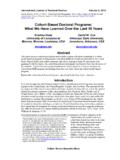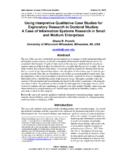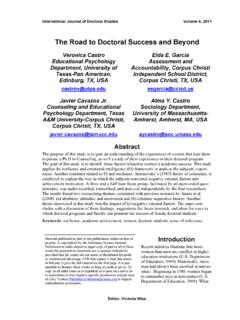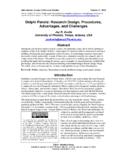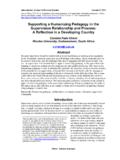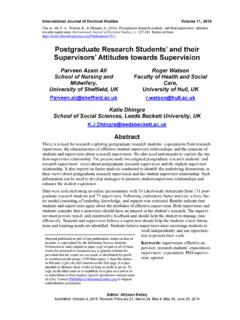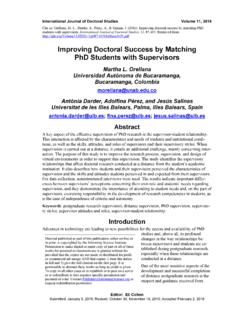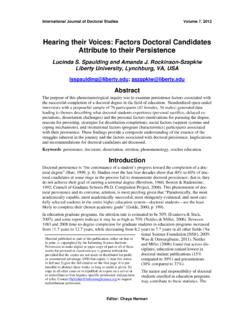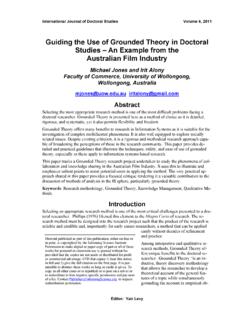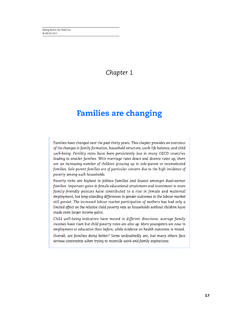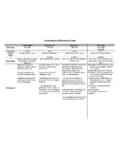Transcription of Striving to Obtain a School-Work-Life Balance: The …
1 International Journal of Doctoral Studies Volume 8, 2013 Striving to Obtain a School-Work-Life balance : The Full-Time Doctoral Student Edna Martinez, Chinasa Ordu, Matthew R. Della Sala, and Adam McFarlane Clemson University, Clemson, SC, USA Abstract The purpose of this study was to explore the doctoral student experience in relation to their school - work -lives. Through a grounded theory research design we sought to explore the follow-ing research question: How, and to what extent, do full-time doctoral students strive to Obtain School-Work-Life balance ? Data were collected through semi-structured interviews and participant observations with five full-time doctoral education students who held one or more graduate assis-tantships on campus. From the data, we constructed four themes. Full-time doctoral students strived to achieve a School-Work-Life balance by (a) purposefully managing their time, priorities, and roles and responsibilities; (b) seeking well-being by managing stress levels, maintaining their mental and physical health, and creating personal time; (c) finding support from various individu-als and their institution; and (d) making tradeoffs.
2 Additionally, we found that single students with no children faced more challenges in efforts to Obtain a School-Work-Life balance in compari-son to their peers with families. Based on our findings, programs can facilitate degree attainment for students by continuing to provide financial support, flexibility in school and work schedules, and support services tailored to specifically address doctoral student needs. Lastly, our partici-pants stories may resonate with other doctoral students, and thus, may help them think about ways to attempt to balance their work and personal lives. Keywords: doctoral students, doctoral student School-Work-Life balance , doctoral student attri-tion, grounded theory Introduction Doctoral level education in the United States is considered to carry significant public and private benefits. For example, as students reap social and financial rewards associated with their degrees, which utlimately extend beyond the individual (Baum, Ma, & Payea, 2010), doctoral degree production enables the country to remain globally competitive (Wendler et al.)
3 , 2010). Additionally, doctoral recipients respective colleges and universities garner prestige (Morphew & Huisman, 2002; O Meara, 2007). In terms of doctoral degree production in the United States Wendler et al. (2010) noted: The US has produced the vast majority of doctoral degrees conferred around the globe. Our graduate schools and their research facilities have been consistently Material published as part of this publication, either on-line or in print, is copyrighted by the Informing Science Institute. Permission to make digital or paper copy of part or all of these works for personal or classroom use is granted without fee provided that the copies are not made or distributed for profit or commercial advantage AND that copies 1) bear this notice in full and 2) give the full citation on the first page. It is per-missible to abstract these works so long as credit is given.
4 To copy in all other cases or to republish or to post on a server or to redistribute to lists requires specific permission and payment of a fee. Contact to request redistribution permission. Editor: Michael Jones School-Work-Life balance ranked among the best in the world ( , the Times of London Rankings and the Shanghai Jiao Tong University Rankings), and from 1997 to 2009 over half of the Nobel Prize winners in chemistry, physics, medicine, and economics had received their graduate de-grees in the US. (p. 2) Nevertheless, these achievements are marred by high student attrition rates. Of the number of students enrolled in doctoral programs across colleges and universities, successful degree completion is unlikely for approximately 50% (Jairam & Kahl, 2012; Walker, Golde, Jones, Bueschel, & Hutchings, 2008). Previous studies centered on doctoral students have identified national attrition rates ranging from 40 to 60% and varying by field of study (Bair & Haworth, 2005; Council of Graduate Schools, 2008; Di Pierro, 2007; Walker et al.)
5 , 2008). Identified as the central issue in doctoral education in the United States today (Smallwood, 2004, para. 8), doctoral student attrition has led to a number of concerted efforts to counter student depature (Gardner, 2009). Despite programmatic and institutional efforts to support and retain doctoral students (Di Pierro, 2007; Offerman, 2011), as well as national initiatives such as the Carnegie Initiative on the Doctorate (Walker et al., 2008), national attrition remains high (Jairam & Kahl, 2012). Given the consideration of measures that are accepted as predictors of academic outcomes ( , test scores) and the degree of screening students undergo prior to admission into a doctoral pro-gram, the rate of student attrition is puzzling. As suggested by Golde (2000), paradoxically, the most academically capable, most academically successful, most stringently evaluated, and most carefully selected students in the entire higher education system doctoral students are the least likely to complete their chosen academic goals (p.
6 199). Nonetheless, it is important to note that student attrition extends beyond academic issues (Brus, 2006; Offstein, Larson, McNeill, & Mwale, 2004) and is influenced by multiple factors (Gardner, 2009). According to Gardner (2009) student attrition is multifaceted since ..there is no one reason why students leave (p. 97). Doctoral student departure has been linked to financial constraints (Kluever, 1997), stress (Lovitts, 2001; Offstein et al., 2004), negative social support (Jairam & Kahl, 2012), matters of advisor incompatibility (Golde, 1998), isolation (Ali & Kohun, 2006), and unmet expectations (Golde, 1998). As Hadjioannou, Shelton, Fu, and Dhanarattigannon (2007) maintain doctoral work is challenging on a variety of levels, stretching often excessively, the minds as well as the emotions, the stamina and the finances of doctoral students (p.
7 160). Doctoral education also involves the stretching of time as doctoral students carry various and often competing roles and responsibilities, each demanding time and attention (Brus, 2006; Haynes et al., 2012; Moyer, Salovey, & Casey-Cannon, 1999; Stimpson & Filer, 2011). Therefore, as suggested by Brus (2006), doctoral students struggle to balance their academic pursuits with their personal lives and responsibilities (p. 31). Given that a balance between personal and academic components of students lives has been identified as helpful for successful degree completion (Brus, 2006; Stimpson & Filer, 2011) and subsequent placement in the academic profession (Brus, 2006), the purpose of this study is to ex-plore full-time doctoral student school - work -lives. Specifically, the following research question guided this study: How, and to what extent do full-time doctoral students strive to Obtain a School-Work-Life balance ?
8 According to Stimpson and Filer (2011), work - life balance is a topic discussed more frequently in the literature concerning faculty than graduate students in higher education (p. 70). Conse-quently, this study contributes to the existing literature by focusing on graduate students work -lives. Further, our study is centered on full-time doctoral education students, which is a minority among education doctoral students (Shulman, Golde, Bueschel, & Garabedian, 2006) and, there-40 Martinez, Ordu, Della Sala, & McFarlane fore, perhaps overlooked in the literature. In addition to the aforementioned contributions, this study generated a working theoretical framework based on participants experiences and views about School-Work-Life balance and helped identify support mechanisms that can be implemented in efforts to foster doctoral student success. Although this study solely focused on doctoral students in the United States ( ), doctoral stu-dent attrition is not a problem limited to the In fact, Australia (Bourke, Holbrook, Lovat & Farley, 2004; Govendir, Ginns, Symons, & Tammen, 2009), Canada (Berkowitz, 2003), and the United Kingdom (Johnes & McNabb, 2004) also report significant attrition rates.
9 Thus, this study may contribute to their efforts to retain doctoral students. In the following section we provide a brief review of the literature centered on work - life balance . Subsequently, we discuss the research design and methodology for this study. Last, we present our findings and provide recommenda-tions for practice. Literature Review Attention to issues of work - life balance has been primarily prompted by demographic changes in the workforce (Beauregard & Henry, 2009; Brus, 2006; Kamenou, 2008). To date, research on work - life balance has been carried out in various contexts including, but not limited to, the medi-cal field (Keeton, Fenner, Johnson, & Hayward, 2007), construction industry (Watts, 2009), and corporate America (Hobson, Delunas, & Kesic, 2001). Additionally, and related to this study, work - life balance has been explored in higher education (Bardoel, De Cieri, & Santos, 2008; Brus, 2006; Byron, 2005; Marshall et al.)
10 , 2012; Moyer et al., 1999; Rosser, 2004; Sallee, 2008; Stimpson & Filer, 2011). In academia, work - life has become a topic of import, so much that over the past decade, work -family balance policies have become a popular [faculty] recruitment tool for research universities (Sallee, 2008, p. 81). However, although work - life balance has ma-terialized as a topic of study and stimulus for policy initiatives in higher education, few studies have considered doctoral student work -lives. Similar to the workforce, the doctoral student population has experienced a demographic shift (Brus, 2006; Offerman, 2011). Today s doctoral students are highly nontraditional (Offerman, 2011). For example, they generally exceed 30 years of age and are increasingly female, married, and/or have children (Offerman, 2011). Consequently, the limited literature on doctoral student work - life has primarily focused on women (Brus, 2006; Haynes et al.
